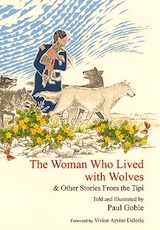Here is a enchanting collection of 26 traditional stories from various Native American tribes recorded during the period from 1890 to 1920. Writer and illustrator Paul Goble says that there are four kinds of stories: (1) Those that entertain, (2) Those that provide a people's history, (3) Those that explain origins, usually in mystical terms. and (4) Those that reveal sacred rites and ceremonies.
The major theme in the book is the cooperation between animals and human beings. We wished that the political leaders in Washington, D.C., could have read The Woman Who Lived with Wolves before they authorized the wholesale slaughter of wolves out West. Reading this Lakota tale reminded us what rare creatures these are, deserving our respect. Goble sums up something we feel as well in his closing remarks:
"We are frightened and lonely people; everywhere birds and animals flee from us in fear. It was never thus during the millennia when Indian peoples shared the land with their bird and animal relatives. Brave Buffalo, Lakota, spoke to Francis Densmore in 1911 for all Indian peoples: 'The animals want to communicate with us, but the Great Spirit does not intend they shall do so directly; we must do the greater part in securing an understanding.' "
You can do your part by sharing The Woman Who Lived with Wolves & Other Stories from the Tipi with children who see animals as companions and friends.
